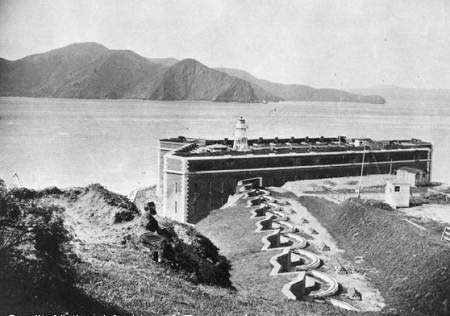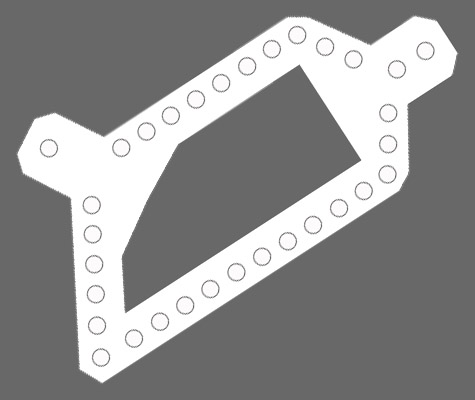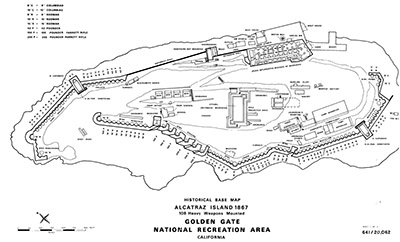 |
Fort Perch Rock
New Brighton, UK
|
|
 |
Constructed: 1825-1839
Used by: Great Britain
Conflict in which it participated:
First World War
Also known as: Perch Rock Battery
|
In 1683, there was a Perch. It was a timber tripod supporting a lantern, intended to allow shipping to safely pass Black Rock...which was, of course, red, but one doesn't argue with olde hystorike naymes.
The city of Liverpool exists at one of the world's great natural harbors, with the big River Mersey and Liverpool Bay providing a protected anchorage for those sailing on the wicked Irish Sea. Located on the left coast of England, it developed into a vastly important window to the western world. And where you have shipping, you have unfortunate idiots who crash their ships into obstacles when approaching an anchorage. |
 |
 |
|
A guiding light was therefore required, and something burning atop a timber tripod was eventually recognized as insufficient, particularly as Liverpool was growing along with the Industrial Revolution, and the flow of ships was ever increasing. Some manner of proper lighthouse was built on Black Rock in the 18th century...because we know that the current lighthouse, now known as New Brighton Lighthouse, replaced a previous lighthouse, and not a pile of rotting logs.
|
 New Brighton Lighthouse, previously known as Perch Rock Lighthouse, previously known as Black Rock Lighthouse: First lit in 1830, decommissioned in 1973. New Brighton Lighthouse, previously known as Perch Rock Lighthouse, previously known as Black Rock Lighthouse: First lit in 1830, decommissioned in 1973. |
 |
But prior the replacement of this mystery lighthouse with the lighthouse that presently stands on Black Rock, there was Napoleon Bonaparte (1769-1821). This small-of-physical-stature yet huge-in-historic-impact Frenchman accomplished a great deal, caused the deaths of a great many and was a great source of worry for England. One of Napoleon's dearest wishes was to subdue his most dangerous enemy by scooting across the English Channel with a vast invasion fleet, which possibility seemed only too likely when the armies of France were unstoppable at the start of the 19th century.
Liverpool was on the wrong side of the British Isles to be directly threatened by the French Navy...or was it? 'Twas universally agreed by everyone in Liverpool that their precious harbor needed a defensive entity as swiftly as possible, but nodding one's head to the necessity of fortification and offering to pay for such a fortification are two different things. And if we've learned anything in our study of starforts, it is that they were ruinously expensive to produce and maintain.
The city of Liverpool had three Napoleonic War desires: It wished for a fort to cover the mouth of the River Mersey; It wished for a lighthouse upgrade; And it wished that Napoleon would leave it alone. The first two wouldn't come to pass during the war, but the last, perhaps most important wish, came true. |
|
|
Liverpool got its financial act together by 1825, and construction of the fort to protect the harbor from Napoleon (who was presently four years dead and buried on the island of Saint Helena) got underway. As it was initially planned, the Fort at Perch Rock would, in addition to covering all ships entering the River Mersey, be home to a fortified lighthouse. For whatever reason this intriguing idea was discarded, and the construction of a new, unfortified lighthouse was initiated in 1827. This would become the New Brighton Lighthouse, which we see above.
Not everyone was pleased with the prospect of an official presence at Perch Rock. Luring cargo ships aground with confusing signals at night, then stealing the goods on those crashed ships for resale, known as wrecking, was a lucrative industry indeed...but it must have been difficult to object to the new fort without revealing oneself for the thieving piece of dirt that one was.
|
Officially known as Perch Rock Battery, our fort was designed by Royal Engineer Captain John Kitson (1792-1835). His design was based at least partially on a plan made in 1814 by another Royal Engineer, named Colonel Pilkington. While the earlier plan was for a "heart-shaped" work with two Martello Tower-like entities, making it sound to me a little like Fort Massachusetts in the Gulf of Mexico...but as adorable a fort as such a design might have produced, Kitson's cooler head prevailed and a semi-trapezoidal scheme was decided upon.
|
 |
 Perch Rock Battery, 1906. |
|
Adobe-and-brush forts were sufficient to defend against little dudes in sombreros wielding pointy sticks, but the navies of Queen Victoria (1819-1901) and Czar Nicholas I (1796-1855) were a different kettle of fish. The US Army Corps of Engineers started work on the Polygonal Fort of Our Current Interest in 1853, "at the foot of the Golden Gate." The Battery at Fort Point is the official name of the structure, but come on, it's a fort, not just a battery. Its construction starting in 1853 made Fort Point one of the very last real forts to be built in the United States: Its relative contemporaries, such as Fort Pulaski, Fort Clinch, Fort Montgomery and Fort Schuyler were all begun around 10 years earlier. Once the US Civil War began in earnest, it became immediately clear that no masonry fortification, regardless of how cleverly and recently built, was capable of withstanding concentrated fire from the latest forms of artillery, which anyone interested in making war against the US was likely to possess. Fort Point was just one stronghold of a defense system intended for San Francisco Bay. Fort Mason was built a bit to the east of the Presidio, and Alcatraz Island was fortified as well.
|
 Fort Point at the end of the US Civil War: Thanks, FortWiki.com! Fort Point at the end of the US Civil War: Thanks, FortWiki.com! |
 |
At the outbreak of the US Civil War, Colonel Albert Sydney Johnston (1803-1862) was commander of the US Army Department of the Pacific, based at the Presidio. Though a Texan, Johnston was opposed to secession.
He would leave the US Army shortly after Texas seceded on March 4, 1861, but Johnston took his post seriously enough to ensure that the Presidio's armory was safely secured from southern sympathizers in the area. There would be no Confederate occupation of California. |
|
|
During the US Civil War, Fort Point was kept armed and ready, but wasn't needed to defend San Francisco from the imagined fleet of deadly steam-powered Confederate ironclad airships. The Presidio functioned as a mustering point for volunteer troops that patrolled Indian lands in California and Oregon, while Federal troops were off doing battle with the Southrons.
|
The Confederacy breathed its last in 1865, but there were still plenty of Indians in need of pacification, so the Presidio continued to serve as a base of operations for America's western shenanigans.
In 1882 Fort Point was officially renamed Fort Winfield Scott. Known as "Old Fuss and Feathers," Winfield Scott (1786-1866) remains to this day the longest-serving general in US Army history. From the War of 1812 through the Civil War, Scott commanded troops in just about every military adventure America had to offer. One imagines the only reason Fort Point was so renamed was that somebody at the War Department looked around and realized with sudden, dawning horror that there wasn't already a fort named after Winfield Scott!
|
 |
Fort Point's gun mounts are identical to those at Fort Pulaski, which isn't the least bit surprising in that they mounted many of the same guns. |
|
Winfield would have been disappointed, however, in that his name never really stuck to the fort, to which you'll note we're still referring as Fort Point.
In 1886, troops were withdrawn from the fort momentarily known as Fort Winfield Scott. The Endicott era of American rearmament did Fort Point no good whatsoever. New batteries for the big guns deemed necessary to deal with notionally aggressive modern navies dotted the San Francisco Bay area, but none were installed at Fort Point. Troops heading for the Philippines during the Spanish-American War (1898) and the following Philippine Insurrection (1899-1902) departed from the Presidio, and some were quartered at Fort Point.
|
 As far as I could find in my standard half-assed research, the Internet had zero full drawings of Fort Point from above. So I made one, based on a partial drawing I found! You're welcome, Internet. As far as I could find in my standard half-assed research, the Internet had zero full drawings of Fort Point from above. So I made one, based on a partial drawing I found! You're welcome, Internet. |
 |
Declared obsolete in 1905, moderately damaged by the Earthquake of 1906, and then abandoned for military purposes in 1914. What else could possibly go wrong for poor, heroic Fort Point?!
The Golden Gate Bridge. Plans for the bridge in the 1930's included the intention to raze Fort Point, but riding to the rescue came the chief engineer of the Golden Gate Bridge, Joseph Strauss (1870-1938). Strauss said, "While the old fort has no military value now, it remains nevertheless a fine example of the mason's art....It should be preserved and restored as a national monument." Strauss redesigned the bridge to allow for the continued existence of Fort Point. |
|
|
Had it not been for this attention as it related to what is now San Francisco's most universally recognized landmark, Fort Point may well have just crumbled into nothingness, or been destroyed in the name of commercial development. A Starforts.com Distinguished Service in the Name of Pseudo-Starfort Preservation Cross has been posthumously awarded to Mr. Strauss. The Presidio continued to be an important military base, sending troops off to fight in all of the fun Asiatic wars in which the US specialized in the second half of the 20th century, until it was finally deactivated and transferred to the National Park Service in 1994. Today, Fort Point is open Friday through Sunday, 10-5, year 'round. Civil War reenactors frequently march thereabout in a purposeful manner. No fort on the west coast of the US ever came under attack...except one, sort of. On the night of June 21-22, 1942, an Endicott Era battery at the mouth of the Colombia River (next to pseudostarfort Fort Stevens) along Oregon's border with Washington, received 17 shells from the deck gun on the Japanese submarine I-25. The commander of Fort Stevens elected not to fire back, and the only thing destroyed by enemy fire was the backstop for the fort's baseball field. Insert culturally insensitive remark about Japanese sailors needing unfashionable round, thick, black-rimmed glasses here.
|
It's impossible to talk about San Francisco Bay without mentioning Alcatraz. During the US Civil War, Fort Alcatraz was the most heavily-armed fortification on the west coast: By 1868 there were 105 large-caliber guns mounted and ready for action on Alcatraz Island, with an additional 50 cannon tubes lying around unmounted.
Our old friend John C. Frémont purchased Alcatraz Island from a Francis Temple for $5,000 in 1846, planning on turning a tidy profit once the US government realized how goshdarned useful it was, appropriated the island and reimbursed him. In 1850, US president Millard Fillmore (1800-1874) ordered that Alcatraz Island be set aside for military purposes, as California was now a US state and surely everyone with a ship would want to immediately invade it.
|
 |
|
|
The US government later invalidated Frémont's purchase of the island and he was paid nothing. Nothing! Frémont and his family carried the reimbursement fight in court until the 1890's, to no avail.
While the many guns of Fort Alcatraz were never needed to defend San Francisco Bay, beginning in the Civil War the government started imprisoning folks there: Deserters, insubordinate soldiers and Confederate sympathizers were among the first to legally be able to wear the coveted I've been incarcerated at the coolest prison in the universe! T-shirt.
|
 Fort Alcatraz, 1867. Thanks again, Fortwiki.com! Fort Alcatraz, 1867. Thanks again, Fortwiki.com! |
 |
Alcatraz was officially made a military prison in 1868, and named the Western US Military Prison in 1907. In 1909 the army did away with most of the fortlike aspects of Fort Alcatraz, in order to make more room to incarcerate folks in need of incarceratin'.
"Conscientious Objectors" were kept on Alcatraz Island during the First World War (1914-1918) because...we can't have those people just running around free, now can we. In 1934 the army turned Alcatraz Island over to the Federal Prison System, and the rest is history. Well, really, all of this is history. Except for the crack about Japanese sailors needing glasses, which was just needless and shameful. |
|
|
|
|
|
|
|
 |




